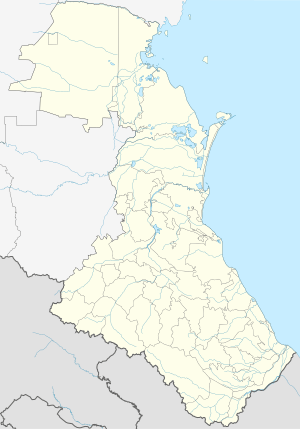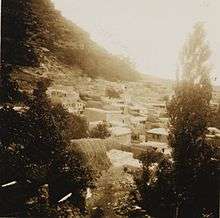Tarki
| Tarki Тарки (Russian) Таргъу (Kumyk) | |
|---|---|
| - Urban-type settlement[1] - | |
.svg.png) Location of the Republic of Dagestan in Russia | |
 Tarki | |
| Administrative status (as of 2013) | |
| Country | Russia |
| Federal subject | Republic of Dagestan[1] |
| Administratively subordinated to | City of Makhachkala[1] |
| City district | Sovetsky City District[1] |
| Municipal status (as of October 2012) | |
| Urban okrug | Makhachkala Urban Okrug[2] |
| Statistics | |
| Population (2010 Census) | 15,356 inhabitants[3] |
| Time zone | MSK (UTC+03:00)[4] |
| Urban-type settlement status since | 1958 |
| Postal code(s)[5] | 367904 |
| 2010 Census | 15,356[3] |
|---|---|
| 2002 Census | 9,858[6] |
| 1989 Census | 3,743[7] |
| 1979 Census | 8,090[8] |

Tarki (Kumyk: Таргъу, Tarğu; Russian: Тарки́), formerly also spelled Terki and Terkee[9] and also known as Tarku[10] (), is an urban locality (an urban-type settlement) under the administrative jurisdiction of Sovetsky City District of the City of Makhachkala in the Republic of Dagestan, Russia, located on the Tarkitau Mountain. As of the 2010 Census, its population was 15,356.[3]
History
According to some scholars, Tarki sits on the site of Samandar, the capital of Khazaria until the early 8th century[11][12]. In 1396, Timur passed through Tarki during the Tokhtamysh–Timur war. In the middle ages the Shamkhalate state is formed, lately becoming Shamkhalate of Tarki. Tarki had been the capital of the Kumyk state at least from the 16th century[13]. This state was not abolished until 1867.
Tarki is mentioned by Armenian chronicles of the 7-8th century[14][15] Giovanni Carpini in 13th century, on the Catalan Atlas of 1375, by Timurid historians

The shamkhals submitted to Russian authority more than once, first in the early 17th century. In 1668, the town was sacked by cossacks under Stepan Razin. The shamkhals were again obliged to submit to Russian suzerainty during Peter the Great's 1722 Persian Expedition and during Catherine the Great's 1796 Persian Expedition.
Tarki finally passed to Russia under the terms of the Treaty of Gulistan (1813). Eight years later, the Russians built Burnaya Fortress there, which was succeeded by Fort-Petrovsk and original Kumyk name Andzhi-kala, now known as Makhachkala.
Deportation

By the decree of Stalin's government on the 12 of April 1944 Kumyk population of historical Kumyk capital Tarki and adjacent villages was deported to the lands of entirely deported to the Middle Asia Chechens (Karachays, Balkars and Crimean Tatars also were deported). The reason was stated as "freeing the area for the agricultural needs" of the resettling there mountaineer peoples. The deportation, despite the Russian laws is still not acknowledged by the Russian government. As a result of this event, local population lost for years their ancient capital of Tarki, which led to the permanent destruction of the majority of the cultural inheritance.[16]
Urban-type settlement status was granted to Tarki in 1958.
Administrative and municipal status
Within the framework of administrative divisions, the urban-type settlement of Tarki is in jurisdiction of Sovetsky City District of the City of Makhachkala.[1] Within the framework of municipal divisions, Tarki is a part of Makhachkala Urban Okrug.[2]
See also
References
Citations
- 1 2 3 4 5 Государственный комитет Российской Федерации по статистике. Комитет Российской Федерации по стандартизации, метрологии и сертификации. №ОК 019-95 1 января 1997 г. «Общероссийский классификатор объектов административно-территориального деления. Код 82 401 673», в ред. изменения №278/2015 от 1 января 2016 г.. (State Statistics Committee of the Russian Federation. Committee of the Russian Federation on Standardization, Metrology, and Certification. #OK 019-95 January 1, 1997 Russian Classification of Objects of Administrative Division . Code 82 401 673, as amended by the Amendment #278/2015 of January 1, 2016. ).
- 1 2 Law #6
- 1 2 3 Russian Federal State Statistics Service (2011). "Всероссийская перепись населения 2010 года. Том 1" [2010 All-Russian Population Census, vol. 1]. Всероссийская перепись населения 2010 года (2010 All-Russia Population Census) (in Russian). Federal State Statistics Service. Retrieved June 29, 2012.
- ↑ Правительство Российской Федерации. Федеральный закон №107-ФЗ от 3 июня 2011 г. «Об исчислении времени», в ред. Федерального закона №271-ФЗ от 03 июля 2016 г. «О внесении изменений в Федеральный закон "Об исчислении времени"». Вступил в силу по истечении шестидесяти дней после дня официального опубликования (6 августа 2011 г.). Опубликован: "Российская газета", №120, 6 июня 2011 г. (Government of the Russian Federation. Federal Law #107-FZ of June 31, 2011 On Calculating Time, as amended by the Federal Law #271-FZ of July 03, 2016 On Amending Federal Law "On Calculating Time". Effective as of after sixty days following the day of the official publication.).
- ↑ Почта России. Информационно-вычислительный центр ОАСУ РПО. (Russian Post). Поиск объектов почтовой связи (Postal Objects Search) (in Russian)
- ↑ Russian Federal State Statistics Service (May 21, 2004). "Численность населения России, субъектов Российской Федерации в составе федеральных округов, районов, городских поселений, сельских населённых пунктов – районных центров и сельских населённых пунктов с населением 3 тысячи и более человек" [Population of Russia, Its Federal Districts, Federal Subjects, Districts, Urban Localities, Rural Localities—Administrative Centers, and Rural Localities with Population of Over 3,000] (XLS). Всероссийская перепись населения 2002 года [All-Russia Population Census of 2002] (in Russian). Retrieved August 9, 2014.
- ↑ Demoscope Weekly (1989). "Всесоюзная перепись населения 1989 г. Численность наличного населения союзных и автономных республик, автономных областей и округов, краёв, областей, районов, городских поселений и сёл-райцентров" [All Union Population Census of 1989: Present Population of Union and Autonomous Republics, Autonomous Oblasts and Okrugs, Krais, Oblasts, Districts, Urban Settlements, and Villages Serving as District Administrative Centers]. Всесоюзная перепись населения 1989 года [All-Union Population Census of 1989] (in Russian). Институт демографии Национального исследовательского университета: Высшая школа экономики [Institute of Demography at the National Research University: Higher School of Economics]. Retrieved August 9, 2014.
- ↑ "Всесоюзная перепись населения 1979 г. Национальный состав населения по регионам России. (All Union Population Census of 1979. Ethnic composition of the population by regions of Russia.)". Всесоюзная перепись населения 1979 года (All-Union Population Census of 1979) (in Russian). Demoscope Weekly (website of the Institute of Demographics of the State University—Higher School of Economics. 1979. Retrieved 2008-11-25.
- ↑ Baddeley (1908), p. 8.
- ↑ Wagner (1854).
- ↑ С.Т.Еремян. Моисей Каланкатуйский о посольстве албанского князя Вараз Трдата к хазарскому хакану Алп-Илитверу. "Записки Института Востоковедения АН СССР", т. VII, М.-Л, 1939.
- ↑ Лавров Л.И. Ученые записки Института истории, языка и литературы ДФ АН СССР", т. 4. 1958
- ↑ С. Белокуров. Отношения России с Кавказом. 1. М., 1888. С. 58-60
- ↑ К.Патканов. из нового списка географии, прописываемой Моисею Хоренскому. "Журнал Министерства народного просвещения", 18 март, стр. 118
- ↑ История халифов Вардапета Гевонда, писателоя VII века. СПб., 1862. С. 28.
- ↑ http://kumukia.ru/хх-век-в-судьбе-кумыков.html
Bibliography
- Народное Собрание Республики Дагестан. Закон №6 от 13 января 2005 г. «О статусе и границах муниципальных образований Республики Дагестан», в ред. Закона №43 от 30 апреля 2015 г. «О статусе городского округа с внутригородским делением "Город Махачкала", статусе и границах внутригородских районов в составе городского округа с внутригородским делением "Город Махачкала" и о внесении изменений в отдельные законодательные акты Республики Дагестан». Вступил в силу со дня официального опубликования. Опубликован: "Дагестанская правда", №8, 15 февраля 2005 г. (People's Assembly of the Republic of Dagestan. Law #6 of January 13, 2005 On the Status and Borders of the Municipal Formations of the Republic of Dagestan, as amended by the Law #43 of April 30, 2015 On the Status of the "City of Makhachkala" Urban Okrug with Intra-Urban Divisions, the Status and the Borders of the Intra-City Districts Comprising the "City of Makhachkala" Urban Okrug with Intra-Urban Divisions, and on Amending Various Legislative Acts of the Republic of Dagestan. Effective as of the day of the official publication.).
- Baddeley, John Frederick (1908), The Russian Conquest of the Caucasus with Maps, Plans, and Illustrations, London: Longmans, Green, & Co. .
- Wagner, Friedrich (1854), Mackenzie, Kenneth, ed., Schamyl and Circassia, 2d ed., London: G. Routledge & Co. .